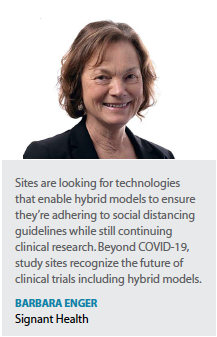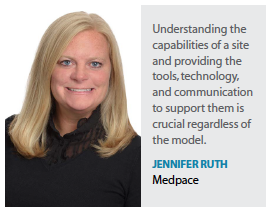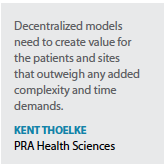Decentralized trials create new opportunities for reaching more patients and safeguarding them during a pandemic, but what do they mean for sites?
The clinical trial landscape has been going through a period of rapid and profound change. Even before the COVID-19 pandemic, trial sites have faced multiple challenges — from financial pressures, to patient recruitment, to investigator engagement and retention.
 According to WCG, the costs of running a clinical trial are not covered by the trial program, but are in fact subsidized at a rate of about 40% by the care side of the business — that is, serving patients in the hospital or healthcare setting. With data from the American Hospital Association putting projected losses to hospitals and health systems at $323 billion in 2020 due to COVID-19, the effect on sites is likely to be severe.
According to WCG, the costs of running a clinical trial are not covered by the trial program, but are in fact subsidized at a rate of about 40% by the care side of the business — that is, serving patients in the hospital or healthcare setting. With data from the American Hospital Association putting projected losses to hospitals and health systems at $323 billion in 2020 due to COVID-19, the effect on sites is likely to be severe.
Clinical trials are also becoming more complex and burdensome for sites, meaning sites need to invest in more advanced technologies and more experienced people.
Yet, data from Elligo Health Research shows that only 3% of physicians participate in clinical trials and, according to WCG Knowledge Base, new investigator participation is down 60% over the past few years. At the same time, trial volume is increasing. Data from clinicaltrials.gov shows a 44% increase in registered studies between 2015 and 2020.
Perhaps the biggest change for sites is the increased move to decentralization or virtual trials — already a drive before COVID-19 amid the push to ease the burden on patients and now in the wake of the pandemic, a growing reality. With the shift to a decentralized or virtualized model, site staff, as important contributors in the clinical research ecosystem, will continue to adapt to these changes, from how they run their business to how they operationalize studies, including by adopting tools and technology to support this new way of working, says Jonathan Cotliar, M.D., chief medical officer, Science 37.
Adjusting to Change
According to surveys conducted by WCG there is, at least conceptually, a high acceptance rate of hybrid trials among both sites and sponsors and the number of hybrid trials is likely to increase significantly.
 “More sponsors are going to start to write protocols with decentralized trials in mind, in part because of the very positive response that sites have had to working this way, leveraging technologies and resources that reduce the burden on them as well as their patients," says Michael Cioffi, senior VP, clinical solutions and strategic partnerships, WCG.
“More sponsors are going to start to write protocols with decentralized trials in mind, in part because of the very positive response that sites have had to working this way, leveraging technologies and resources that reduce the burden on them as well as their patients," says Michael Cioffi, senior VP, clinical solutions and strategic partnerships, WCG.
Our experts largely agree that site support for virtual is strong, and that the COVID pandemic has simply served to accelerate this acceptance. “With COVID-19, we saw a dramatic increase in the use of telehealth and connected health to conduct standard patient visits along with remote data capturing using wearables to transmit patient data to care providers and physicians," says Kent Thoelke, executive VP and chief scientific officer at PRA Health Sciences. “And much of what is being deployed in decentralized trials today was already being used by sites.
Therefore, much of the apprehension to deploy decentralized functions as part of a trial has diminished at the site level."
Sites have adjusted to the pandemic by focusing on two principles: patient safety and collecting reliable data in a protocol compliant manner, says Barbara Enger, associate VP, clinical science, Signant Health.
Mark Hanley, CEO of VirTrial, says while in the past sites were concerned that sponsors would replace them with technology in fully virtual trials, that’s not the case, and today sites recognize that hybrid designs need to become the norm.
Mr. Thoelke says while there might be doubts about virtualizing clinical trials, these concerns will likely drop away as technologies become more integrated, and the patient and medical benefits are realized.
 Casey Orvin, senior VP of pharmaceutical relationships at StudyKIK, says sites would benefit from decentralized training or knowledge on what it means to be part of a virtual study. “Once they understand what a virtual trial entails, site staff are more likely to want to be a part of it and incorporate it into their business model," he says.
Casey Orvin, senior VP of pharmaceutical relationships at StudyKIK, says sites would benefit from decentralized training or knowledge on what it means to be part of a virtual study. “Once they understand what a virtual trial entails, site staff are more likely to want to be a part of it and incorporate it into their business model," he says.
Sponsors also need to recognize where a site is on its digital journey and recognize that some sites will need more time to adopt new systems than others, Mr. Hanley says.
Jackie Kent, executive VP, head of product, at Medidata, says additionally, sites need technology solutions that allow them to run clinical trials in the most efficient manner and collect the data that is needed to bring medicines to the market.
Tackling Remote Challenges
Experts say there are a number of challenges in adjusting to a decentralized model — for patients, sponsors, and sites.
From a patient point of view, there may be some hesitation because they won’t see their doctor at every visit. Research shows having a trusted doctor involved in the study provides a level of confidence and security.
“Instead of attending a screening visit in person, in a decentralized world some intake visits are conducted virtually, which removes the comfort of having a medical professional present," Mr. Orvin says. He adds that if patients aren’t coming to a site for every visit, then procedures need to be in place to ensure proper PI oversight to ensure the safety of the patient and the quality of the data. Sponsors also are being impacted by decentralization since they must implement new processes to enable televisits to take place. In addition, CRAs and monitors need to be trained on how to conduct visits virtually.
Mr. Cioffi also notes that decentralization challenges include new SOPs, dealing with technology, and managing patient engagement and retention, which, although a challenge anyway, becomes slightly more complex in a virtual format.
“It’s a lot easier to keep patients engaged when they’re coming to a site every two weeks or whatever the schedule is based on the protocol," he says. “Whether via mHealth or other tools, leveraging technology to remotely engage patients is critical to keeping the communication going between patients and investigative sites, helping to ensure data is collected appropriately and in a timely manner."
Another challenge is incorporating investigators’ extremely busy schedules into coordinating study visits that need to be conducted at home, Dr. Cotliar points out.
“Sites will need to ensure that there’s an adequate amount of time to staff these visits at a mutually convenient time for the investigator and the patients," he says.
Sponsors also need to consider the workflow and resources needed for virtual trials versus traditional ones. “The staffing needs for virtual study visits are much  different than how site-based study team personnel — coordinators and research nurses — are typically deployed to staff in-person study visits," Dr. Cotliar says.
different than how site-based study team personnel — coordinators and research nurses — are typically deployed to staff in-person study visits," Dr. Cotliar says.
Ms. Enger says direct feedback from study sites through a site advisory board can be the most critical factor in defining study site needs and tailoring industry responses. “The study site maintains the clearest vision on the integration of medical care responsibilities within the conduct of a clinical trial," she says. “It is important that industry professionals communicate often and transparently with investigators so solutions can match the real-world needs of site and participants."
Sponsors and their CRO partners need to work closely with sites to make sure the decentralized and hybrid-decentralized models are not creating additional burden, but, where possible, are closely integrated into standard patient care flows, Mr. Thoelke says.
“The use of connected health devices, as well as telehealth that is integrated into decentralized trials, needs to ensure that the data collected is systematically pushed to providers so they can use these new data streams not only in support of decentralized clinical trials, but simultaneously for patient care," he says. “The data architecture associated with any decentralized trial must take into account the complexity of how data is collected remotely in a compliant environment and how it is pushed to sponsors and site staff while ensuring data and patient privacy.
Where possible, decentralized trials should integrate with existing platforms used by sites for telehealth and telemedicine to minimize additional site burden."
Nevertheless, Mr. Cioffi says the ability to create and run hybrid trials will ultimately reduce patient burden, which in turn will reduce site burden.
While adoption of decentralized trials has accelerated, there is no one-size-fits-all approach, says Jennifer Ruth, executive director, quality assurance and process improvement, Medpace. What is most important, she says, is strong site relationships, open communication, and an understanding of each site’s capabilities and resources. “We can then provide the appropriate support and tools to drive success, whether that means virtual, on-site or a hybrid approach," she says.
Adapting to New Technologies
According to Mr. Hanley, technology to enable decentralized trials is not about replacing sites but rather augmenting how they interact with patients. “A good decentralized trial solution will seek to recreate what we know works in the clinic, the workflows and processes that we’ve refined for decades, making the transition smoother for both sites and patients," he says.
 Dr. Cotliar says the emphasis should lie on having a technology platform that can house all the data, whether the data is collected by patients or a mobile nurse in the home or in the traditional way in the clinic. “Being able to capture all of those activities would be hugely important, not just for efficiency but also for data standardization," he says. “The technology has other implications as well, for example, a platform’s ability to integrate with existing electronic health record systems can reduce or remove double data entry altogether, so you can make the trial experience as seamless as possible for investigators who already have a tremendous amount of paperwork, whether physical or digital, that they’re responsible for in their day-to-day lives. Ultimately, sites may find that they can run trials more efficiently."
Dr. Cotliar says the emphasis should lie on having a technology platform that can house all the data, whether the data is collected by patients or a mobile nurse in the home or in the traditional way in the clinic. “Being able to capture all of those activities would be hugely important, not just for efficiency but also for data standardization," he says. “The technology has other implications as well, for example, a platform’s ability to integrate with existing electronic health record systems can reduce or remove double data entry altogether, so you can make the trial experience as seamless as possible for investigators who already have a tremendous amount of paperwork, whether physical or digital, that they’re responsible for in their day-to-day lives. Ultimately, sites may find that they can run trials more efficiently."
Mr. Hanley notes that technology readiness varies with some sites having already moved to e-source or e-consent, while others are less familiar with these technologies and will need more time to implement them.
Ms. Kent says as technologies to support telehealth visits expand, the relationship between the sites and patients is becoming more focused on patient care and support.
Technology also will require extensive training for site staff, experts point out. “If a patient has an issue or something goes wrong with a telehealth visit, the patient will call the site for assistance," Mr. Orvin says. “Coordinators and site staff will need to be taught how to use and navigate the apps and software that both they and the patients will use. And time must be spent ensuring the patient can use and is using the technology correctly."
Technology, however, can also be a barrier, he adds. Sites are expected to work with multiple vendors, which means learning different systems and portals. Decreasing the number of vendors would reduce the burden for sites.
Ms. Kent agrees the expansion in technology adoption — from electronic data capture to sites now having to learn about mobile devices such as smartphones and tablets as well as sensors — can be a challenge. “However, it also presents an opportunity to have more timely access to the entire set of patient data, resolve issues faster, and ensure patient compliance and safety," she says.
Creating Opportunity
While decentralization will take some adjustment, there are huge benefits to be had for all stakeholders, experts say.
“Rather than focusing on a geographical area close to the physical location of the site, the site can now recruit patients further away," Mr. Orvin says. “With new technology and telemedicine, sites now have the opportunity to not only enroll more patients on their current studies, but they can also participate in more protocols since coordinators who would normally have been spending time with patients at the site for every visit, now have more time. All of this leads to an industry goal of getting new and better treatments to more patients in a shorter period of time."
For patients, virtual visits mean more flexibility, missing fewer hours at work and not having to travel to the clinic for simple questionnaires and check-ups, our experts say. Indeed, technologies such as patient apps, e-consent, and virtual screens provide greater convenience to study participants.
 Ms. Kent believes the role of the site may actually expand with virtual as their engagement with the patient becomes front and center. “Ensuring patients understand the trial they are consenting into and feel well educated in the protocol and the journey they will undertake are keys to the success for patients and the overall completion of the clinical trial," she says. “The site is in the best position to support patients."
Ms. Kent believes the role of the site may actually expand with virtual as their engagement with the patient becomes front and center. “Ensuring patients understand the trial they are consenting into and feel well educated in the protocol and the journey they will undertake are keys to the success for patients and the overall completion of the clinical trial," she says. “The site is in the best position to support patients."
Dr. Cotliar says sponsors need to continue to retain engagement with sites, as many are tied to key opinion leaders who they’re  working with as part of their standard drug development process. “It will be important for these same KOLs to advocate for telemedicine and virtual visits on behalf of patients, when feasible, because generally speaking, the industry follows the KOLs," he says.
working with as part of their standard drug development process. “It will be important for these same KOLs to advocate for telemedicine and virtual visits on behalf of patients, when feasible, because generally speaking, the industry follows the KOLs," he says.
Ms. Ruth says to help alleviate site burden, high-quality personnel, such as clinicians, should be deployed as additional resources. “There are other services such as patient scheduling that can be taken on to further reduce burden for site personnel and thereby increase the site’s ability to maximize enrollment efforts," she says.
Perhaps the biggest advantage of the move to virtual, Mr. Thoelke says, is the opportunity to bring greater diversity to clinical trials — a change that is much needed given that the majority of clinical trial sites are in urban areas and primarily include a very homogenous population of white, middle-aged men. “The use of decentralized trials, connected health, telehealth/mobile health, telemedicine, and home health nursing creates a model that can help democratize access to clinical research as a care option — providing clinic staff more options for their patients," he says.(PV)
~~~~~~~~~~~~~~~~~~~~~~~~~
Balancing Acts
As sponsors seek to balance recruitment and retention of patients to clinical trials with meeting the needs and expectations of trial sites, they will need to take a carefully considered approach. Our experts talk about how to manage all the considerations.
Jonathan Cotliar, M.D.
Chief Medical Officer, Science 37
Most sponsors are keenly aware of the valuable input that they get from patients, and that’s typically in partnership or through dialogue with advocacy groups and patients themselves to inform how a particular protocol is developed. Certainly, this important patient input in conjunction with the internal scientists, medical leads, and KOLs will continue to drive the drug development process. Being thoughtful about where decentralization may add the most value to patients will be an additional consideration moving forward for biopharma organizations.
Mark Hanley
CEO, VirTrial
Sponsors should recognize that sites and patients are both essential to a successful trial. Sponsors should help sites understand this will be a transition in the industry and they are critical in helping patients in this transition too. Sponsors should consult with sites to understand their specific challenges, and not assume one challenge at a site will be the same for another site. Luckily, for the most part, the needs of patients and sites are often aligned. Sites do not want fully in-person trials where they are not needed. Patients do not want a fully virtual trial where they never establish a relationship with the site. Patients do not want to travel to the site for every protocol visit if it is avoidable, so sponsors should reimburse sites the same whether an activity takes place on-site or in a virtual setting. Additionally, both patients and sites deserve proper, tried-and-tested tools.
Casey Orvin
Senior VP of Pharmaceutical Relationships,
StudyKIK
Sites play the most crucial part when it comes to patient recruitment and engagement. Sites are often spread thin when it comes from re-engaging patients from their database to handling the recruitment of potential patients. This leaves little room for the site’s staff to effectively engage patients when the time comes for screening. When a patient randomizes into the study, it’s oftentimes those same staff members who are required to handle the retention of those patients. Offering sites tools to assist with recruitment, engagement, and retention will help them be more successful in their trials. Sponsors also need to continually seek the advice of the sites. Truly listening and understanding their strengths and weaknesses is paramount. The recruitment and retention efforts that work extremely well for some sites may not be what is needed at other sites. Sponsors must provide the sites with the means, both financially and through tech support, to accomplish their recruitment and retention goals. I think an important piece that is often missing, is the assumption that sites do not need advertising and recruitment funds to successfully enroll patients. Oftentimes databases are old and even if the site has the patients in their database, creativity and funds are necessary to reach the potential patients. New technologies and new processes, especially in the months since COVID, have allowed our industry to make advancements within telemedicine like never before. With the ease of apps and software, it’s much easier to check in on the patients through text, surveys, and even videos. Giving patients the opportunity to participate in a research study from the comfort of their home is vastly changing the way we conduct trials.
Kent Thoelke
Executive VP and Chief Scientific Officer,
PRA Health Sciences
As a result of COVID-19, the reality is the demands and needs of sponsors, patients, and sites are closely aligned. All three stakeholders are looking to ensure we can maintain the ability for patients to participate in clinical trials while minimizing the risk of patients becoming infected with COVID-19. All stakeholders are also looking to leverage telehealth, telemedicine, connected health, and in-home health to provide greater access to patient care and disease management during COVID-19.
And, all three stakeholders are looking at ways to blend this new patient care model with clinical trial designs. That said, relative to clinical trials, it is incumbent upon sponsors to do a better job of optimizing clinical trial designs and schedule of events to prioritize in-home, or remotely-collected, data points, and to minimize the need for in-person clinic visits when possible to make trials more patient-centric during COVID-19. Sponsors should be investing to support patient participation in clinical trials in decentralized trial models by replacing traditional in-person visits with telehealth/telemedicine and connected health-based trials.

















